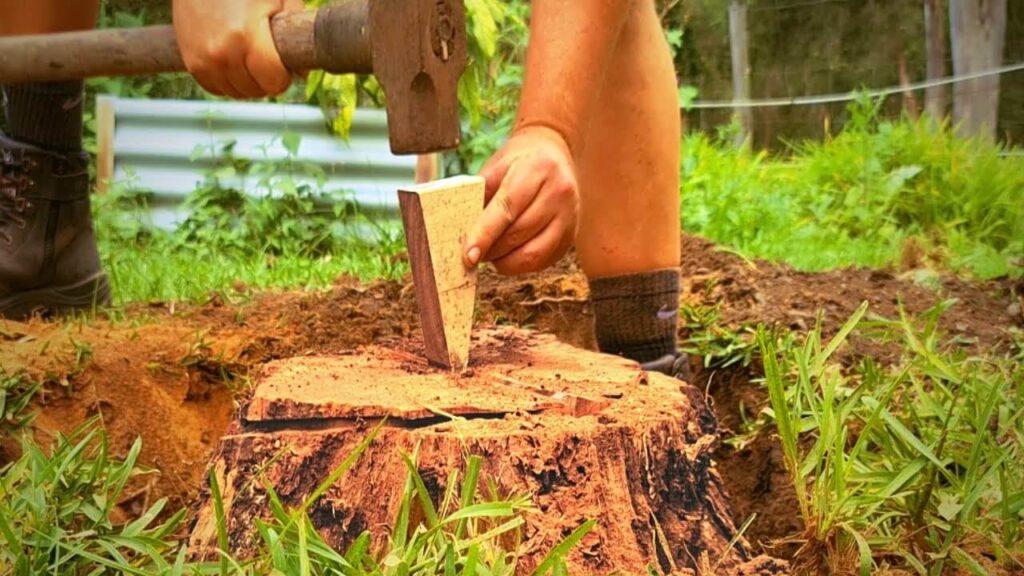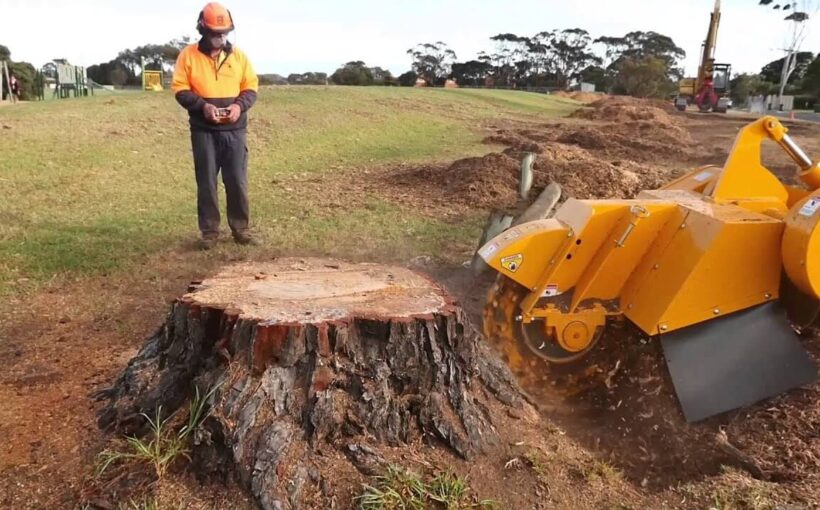Tree stump removal is often overlooked when it comes to tree maintenance, but its importance should not be underestimated. Although stumps may seem harmless, they can actually have a significant impact on your landscape and the health of your trees. In this article, we will explore the reasons why tree stump removal matters and the benefits it can bring to your property.
Understanding the Importance of Tree Stump Removal
Tree stump removal plays a crucial role in maintaining the overall health and appearance of your landscape. It goes beyond simply getting rid of an eyesore; it involves eliminating potential risks and promoting the growth of healthy trees. By delving into the key aspects of tree stump removal, we can gain a better understanding of why it is an essential part of tree maintenance.
The Role of Tree Stump Removal in Tree Maintenance
One of the primary reasons to remove tree stumps is to prevent unwanted regrowth. When a tree is cut down, the stump may sprout new shoots, leading to a cluster of small trees growing in the same area. These shoots can be difficult to manage and can eventually impact the growth of nearby trees. By removing the stump, you eliminate the source of this regrowth and encourage the development of healthier trees.
Additionally, tree stumps can pose physical hazards in your landscape. They can be tripping hazards, especially if they are hidden by grass or other vegetation. This can be particularly dangerous for children or elderly individuals who may not see the stump and accidentally trip over it. By removing tree stumps, you create a safer environment for everyone.
Furthermore, tree stumps can interfere with the aesthetics of your landscape. They can be unsightly and disrupt the overall visual appeal of your outdoor space. Removing tree stumps allows you to create a more visually pleasing environment, enhancing the beauty of your landscape. Learn more methods for tree stump removal.
The Environmental Impact of Leaving Tree Stumps Behind
Leaving tree stumps behind can also have a negative impact on the environment. Stumps can attract pests such as termites, beetles, and ants, which can then spread to other living trees in your landscape. These pests can cause significant damage to your trees, compromising their health and stability. By removing tree stumps, you eliminate the potential breeding ground for these pests and protect the overall health of your landscape.
Furthermore, as stumps decay, they release carbon dioxide into the atmosphere, contributing to greenhouse gas emissions. This can have a detrimental effect on the environment and contribute to climate change. Removing tree stumps helps mitigate these environmental concerns and promotes a healthier ecosystem.
Moreover, removing tree stumps allows for better land utilization. Stumps can take up valuable space in your landscape, limiting your options for planting new trees or other vegetation. By removing these stumps, you free up space and create opportunities for new growth and landscaping projects.
In conclusion, tree stump removal is not just about getting rid of an eyesore. It plays a vital role in tree maintenance, preventing unwanted regrowth, eliminating physical hazards, and enhancing the aesthetics of your landscape. It also has significant environmental benefits, protecting against pest infestations, reducing greenhouse gas emissions, and allowing for better land utilization. By prioritizing tree stump removal, you can ensure the long-term health and beauty of your outdoor space.
The Process of Tree Stump Removal
Effective stump removal requires the right tools and techniques to ensure a thorough job. While it may be tempting to attempt the task yourself, it is important to consider safety measures and the possible complications that can arise. To better understand the process, let’s explore the tools and techniques involved in tree stump removal.
When it comes to removing a tree stump, there are several tools and techniques that can be employed. The choice of tools depends on the size and complexity of the job. One commonly used tool is a stump grinder. Stump grinders are powerful machines that are designed to grind stumps into small wood chips. This method is highly efficient, as it breaks down the stump gradually, making removal easier. Stump grinders come in various sizes, allowing them to tackle stumps of different diameters. For larger stumps, a larger stump grinder with more horsepower may be required.
Alternatively, if the stump is small and easily accessible, it can be extracted using a stump puller or a chainsaw. A stump puller is a specialized tool that allows for the extraction of stumps by leveraging mechanical force. Chainsaws, on the other hand, can be used to cut the stump into smaller, more manageable pieces. This method is often employed when the stump is located in a tight space or when the surrounding area needs to be protected.
It is worth noting that removing a tree stump can be a labor-intensive task, especially if the stump is large or deeply rooted. In such cases, it is advisable to seek the assistance of a professional tree removal service. These professionals have the experience and expertise to handle stump removal efficiently and safely. They can assess the specific situation and determine the best approach, taking into consideration factors such as the type of tree, the condition of the stump, and the surrounding environment.

Safety Measures to Consider During Stump Removal
While removing a tree stump may seem like a straightforward task, it is essential to prioritize safety. Proper protective gear should always be worn to prevent injuries. This includes gloves to protect your hands from sharp debris, goggles to shield your eyes from flying wood chips, and sturdy footwear to provide traction and protect your feet.
In addition to wearing the appropriate gear, it is crucial to assess the surrounding area for potential hazards. Before starting the stump removal process, it is important to locate and mark any underground utility lines, such as gas or water pipes, to avoid damaging them. It is also advisable to clear the area of rocks or other debris that may pose a tripping or falling hazard.
Furthermore, it is important to consider the stability of the stump itself. If the stump is rotted or unstable, it may pose a risk of collapsing unexpectedly. In such cases, extra caution should be exercised, and it may be necessary to reinforce the stump or take additional safety measures.
By taking these safety measures into account, you can minimize risks and ensure a smooth stump removal process. Remember, safety should always be the top priority when undertaking any tree-related task.
The Benefits of Tree Stump Removal
Beyond the practicalities of stump removal, there are numerous benefits that make it a worthwhile investment. Let’s explore some key advantages of removing tree stumps from your landscape.
Enhancing Aesthetic Appeal of Your Landscape
Tree stumps can be unsightly and disrupt the visual harmony of your landscape. Removing them can greatly improve the overall aesthetics, particularly in areas such as gardens, lawns, or driveways. By eliminating these obstacles, you create a cleaner and more visually pleasing environment.
Imagine a beautifully manicured garden with vibrant flowers, lush green grass, and neatly trimmed hedges. The absence of tree stumps allows the eye to flow smoothly across the landscape, without any interruptions. Your outdoor space becomes a tranquil oasis, inviting you to relax and enjoy the natural beauty.
Additionally, removing tree stumps opens up new possibilities for landscaping. You can now consider adding features like a cozy seating area, a charming water fountain, or even a small pond. With the stumps gone, you have a blank canvas to unleash your creativity and transform your outdoor space into a personal paradise.
Preventing Tree Diseases and Pest Infestation
As mentioned earlier, tree stumps can attract pests and become breeding grounds for harmful organisms. By removing stumps promptly, you reduce the risk of tree diseases and the spread of pests to healthy trees. This preventive measure can save you from potential future setbacks and the need for costly tree treatments.
When a tree is cut down, the stump left behind can decay over time. This decaying process attracts insects, such as termites and beetles, which can then infest nearby trees. These pests can cause significant damage to the healthy trees in your landscape, compromising their structural integrity and overall health.
Furthermore, decaying stumps can harbor fungal diseases that can spread to other plants in your garden. These diseases can weaken the plants’ immune systems, making them more susceptible to other infections and reducing their lifespan. By removing tree stumps, you eliminate potential breeding grounds for pests and diseases, ensuring the long-term health of your landscape.
Not only does stump removal protect your existing trees, but it also prevents the need for extensive pesticide use. By addressing the root cause of pest infestations, you reduce the reliance on chemical treatments, promoting a more environmentally friendly approach to landscaping.

Common Misconceptions About Tree Stump Removal
Despite the numerous benefits and the importance of tree stump removal, there are still common misconceptions that surround this process. Let’s debunk some of these myths and gain a clearer understanding of the reality.
Debunking Myths About Stump Removal
One myth is that leaving a tree stump provides a sturdy base for future construction projects. However, stumps can rot over time, compromising their stability. Another misconception is that stumps will naturally decay and disappear on their own. While decay does occur, it takes a significant amount of time, during which the stump can become a breeding ground for pests and diseases.
Why Stump Removal is Not a DIY Job
Attempting to remove a tree stump yourself can be challenging and potentially dangerous. DIY stump removal requires specialized tools and expertise to ensure a thorough job. Professional tree removal services are equipped with the necessary equipment and have the expertise in dealing with different types of stumps. By enlisting their services, you can save time, avoid unnecessary risks, and achieve optimal results.
Hiring Professionals for Tree Stump Removal
When it comes to tree stump removal, seeking the expertise of professionals can make a significant difference. Let’s explore what you should consider when hiring a tree stump removal service.
What to Look for in a Tree Stump Removal Service
When selecting a tree stump removal service, consider factors such as experience, reputation, and reliability. Look for companies that have a track record of successfully removing stumps and maintaining a high level of customer satisfaction. Requesting references and reading reviews can help you make an informed decision and ensure that the service provider meets your expectations.
The Cost of Professional Stump Removal Services
The cost of professional stump removal services can vary depending on various factors, including the size and number of stumps, accessibility, and the complexity of the job. It is advisable to obtain multiple quotes from different service providers to compare prices and services offered. Although it may involve an upfront investment, professional stump removal is a cost-effective solution in the long run, considering the benefits and potential problems it helps avoid.
In conclusion, tree stump removal is an unsung hero in tree maintenance. It plays a vital role in preserving the health of your trees, preventing environmental issues, and enhancing the overall appearance of your landscape. By understanding the importance of stump removal, debunking common misconceptions, and considering professional services, you can ensure a healthier and more visually appealing outdoor space.
More to read: How Much Does It Cost to Grind Stumps
